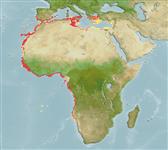Classification / Names
Common names from other countries
Main reference
Size / Weight / Age
Max length : 60.0 cm TL male/unsexed; (Ref. 57392); common length : 35.0 cm TL male/unsexed; (Ref. 3397); max. published weight: 1.0 kg (Ref. 27584)
Length at first maturity
Lm ?, range 20 - ? cm
Environment
Marine; brackish; benthopelagic; depth range 30 - 200 m (Ref. 27584), usually 30 - 50 m (Ref. 26999)
Climate / Range
Subtropical; 15°C - 22°C (Ref. 57055), preferred 24°C (Ref. 107945); 39°N - 22°S, 19°W - 36°E
Distribution
Short description
Dorsal
spines
(total): 9;
Dorsal
soft rays
(total): 28-32;
Anal
spines: 3;
Anal
soft rays: 25 - 28. Diagnosis: body elongate and slightly compressed, its depth comprised from 3.8 to 4.4 times in fork length; eye posteriorly with a well developed adipose eyelid; 2 well separated dorsal fins, 1st with 8 spines, 2nd with 1 spine and 28-32 soft rays; anal fin with 2 detached spines, followed by 1 spine and 25-28 soft rays; last dorsal and anal ray transformed into a partially separate finlet, connected to the preceding ray by a low interradial membrane; pectoral fins short (comprised from 1.0 to 1.2 times in head length); scales small and cycloid; curved part of lateral line with 45-55 scales and 0-3 scutes, straight part with 0-8 scales and 24-32 scutes (Ref. 57392).
Coloration: back brownish to olivaceous, sides light olivaceous to whitish; a narrow yellowish band sometimes extending from head to caudal-fin base; a black spot on upper margin of gill cover; a black blotch with a narrow light distal margin present on second dorsal-fin lobe (Ref. 57392).
IUCN Red List Status (Ref. 115185)
Threat to humans
Harmless
Human uses
Fisheries: commercial
More information
ReferencesAquacultureAquaculture profileStrainsGeneticsAllele frequenciesHeritabilityDiseasesProcessingMass conversion
Tools
Special reports
Download XML
Internet sources
Estimates of some properties based on models
Phylogenetic diversity index
PD50 = 0.5000 many relatives (e.g. carps) 0.5 - 2.0 few relatives (e.g. lungfishes)
Trophic Level
3.6 ±0.59 se; Based on food items.
Resilience
Medium, minimum population doubling time 1.4 - 4.4 years (K=0.16-0.3; Fec = 480,000)
Vulnerability
Moderate vulnerability (36 of 100)
Price category
